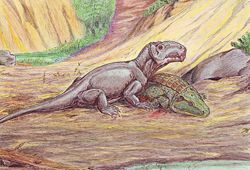Synapsids
Non-mammalian
| Name | Status | Authors | Age | Unit | Location | Notes | Images |
|---|---|---|---|---|---|---|---|
Kutorga | A member of Dinocephalia. |  | |||||
Nomen dubium | Kutorga | Late Permian | A member of Dinocephalia. | ||||
Valid | Kutorga | A member of Dinocephalia. | |||||
| List of years in paleontology |
|---|
| (table) |
Paleontology or palaeontology is the study of prehistoric life forms on Earth through the examination of plant and animal fossils . [1] This includes the study of body fossils, tracks ( ichnites ), burrows , cast-off parts, fossilised feces ( coprolites ), palynomorphs and chemical residues . Because humans have encountered fossils for millennia, paleontology has a long history both before and after becoming formalized as a science . This article records significant discoveries and events related to paleontology that occurred or were published in the year 1838.
| Name | Status | Authors | Notes | |
|---|---|---|---|---|
Valid | Meyer | |||
Valid | von Meyer | |||
| Name | Status | Authors | Age | Unit | Location | Notes | Images |
|---|---|---|---|---|---|---|---|
Kutorga | A member of Dinocephalia. |  | |||||
Nomen dubium | Kutorga | Late Permian | A member of Dinocephalia. | ||||
Valid | Kutorga | A member of Dinocephalia. | |||||
| Name | Status | Authors | Age | Unit | Location | Notes | Images |
|---|---|---|---|---|---|---|---|
Agassiz, 1838 | A chimeric shark, junior synonym of Otodus chubutensis and O. megalodon . |
| Name | Status | Authors | Age | Unit | Location | Notes | Images |
|---|---|---|---|---|---|---|---|
Valid | Australia, North America, South America, Europe and Portugal. | Possible synonym of Carcharodon hastalis . |
| Name | Status | Authors | Age | Unit | Location | Notes | Images |
|---|---|---|---|---|---|---|---|
Valid | An extinct shark. |